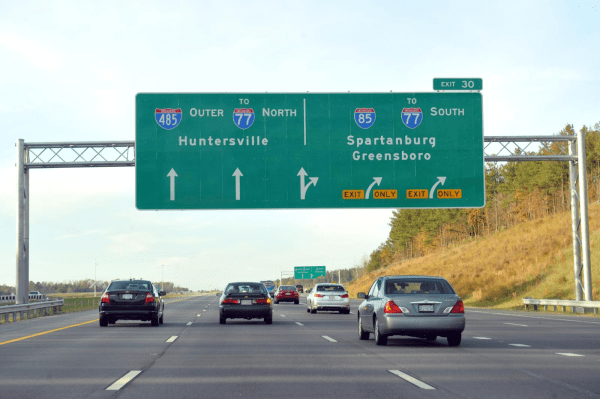Getting around: A snapshot of transportation policy in the United States and Greater Charlotte region

I’m an avid podcast listener. Subscribing to shows with focus areas ranging from philosophy to policy to pop culture keeps me not only entertained, but also informed for my job as the director of public policy research at the Charlotte Urban Institute.
Last Friday, the NPR-affiliated “Memory Palace” featured two poems about public transportation. Given my recent work on a policy brief about transit in the Charlotte region, it caught my attention. One in particular by Walt Whitman stood out: “Crossing Brooklyn Ferry,” written in the 19th century, is an ode to the democratizing power of public transportation in cities.
Whitman connects to his fellow travelers across both time and space. Hearing his words reminded me of my own affinity for people-watching while riding the LYNX or the Amtrak to Raleigh with my son:
Crowds of men and women attired in the usual costumes, how curious you are to me!
On the ferry-boats the hundreds and hundreds that cross, returning home, are more curious to me than you suppose.
Whitman goes further, reaching out to future readers, suggesting that the shared act of travel binds us together:
I am with you, you men and women of a generation, or ever so many generations hence,
Just as you feel when you look on the river and sky, so I felt,
Just as any of you is one of a living crowd, I was one of a crowd.
The Fulton Ferry that Whitman rode is gone, made obsolete by the construction of the Brooklyn Bridge in 1883. But his sentiment holds true. Here in Charlotte, while we may not be crossing rivers on the way to work, I still get that same feeling of curiosity about my fellow commuters, even as I’m trying to merge onto I-77 at exit 23, a decidedly less poetic crossing.
Transportation, whether on foot, bus, train, or car is a lens that magnifies larger societal dynamics. On the one hand, it’s one of those near-universal experiences that unites us; yet, as with housing, education, and health, we experience it differently depending on who we are. Conflicts arise when our individual subjectivities clash with each other, rather than co-incorporate.
In Charlotte, 3.7% of households lack reliable access to a personal vehicle. This is well below the national average of 8.6%. That statistic underscores what many know – ours is a car-dependent city. Ridership has fallen for both bus and light rail in recent years and, for many, public transportation is a curiosity or last resort, rather than a vital civic amenity.
There are two challenges with this. First, data from the City’s 2020 Strategic Mobility Report show that households without cars are concentrated in inner-ring “crescent” suburbs to the east, west, and north of Uptown. Many of these areas lack sidewalk infrastructure and other forms of pedestrian or bike connectivity. This means that, for some Charlotteans, public transportation usage isn’t optional.
The second challenge is more personal. It’s the nagging sense of loss I feel when I listen to Whitman’s poem. For him, the ferry was a place of sun-soaked reflection and connection. For me, a reader in the future, that lightness still exists – on a train, where I can relax, let the city pass by, and feel like I’m a part of something larger. Too often, though, transit in whatever form we experience it is a form of stress and isolation.
Recent violence on public transit here in Charlotte has disrupted the sense of shared humanity that Whitman celebrated. These episodes bring layers of fear and helplessness to the already-politically charged debate about the 1-cent transit tax, scheduled to be on the ballot this November.
The Charlotte region is at a crossroads. With an estimated 157 residents arriving each day, transportation is one of many quality of life related issues we will grapple with as a rapidly urbanizing community. And with limited resources, outcomes are contested.
For me, hope lies in small moments of connection. The photo below is from 2022, when my son and I finally got the chance to ride the Blue Line all the way from UNC Charlotte to Pineville, as pandemic-era restrictions began to ease. In laughter, casual chitchat, and silence, we watched the city slip by in the backs of buildings and alleyways. We rode alongside college students, workers, unhoused neighbors, and Panthers fans. For that afternoon, the LYNX felt like Whitman’s ferry: democratic, diverse, alive.

Whitman’s poem reminded me that transit is not only about “getting around” but also about how we share space as a species.
A part of our mission at the Urban Institute, is to equip changemakers with the data and insights needed to build a thriving region. I hope you find this Story Map informative. It is first of many the Institute will publish about issues related to quality of life in our region. We’d love to hear what you think and what you’d like us to publish next.
Until next time, I’ll leave you with a few more words from Whitman (bolded words edited, by me, for fun).
What is it then between us?
What is the count of the scores or hundreds of years between us?
Whatever it is, it avails not—distance avails not, and place avails not,
I too lived, Brooklyn Charlotte of ample hills cars was mine,
I too walk’d the streets of Manhattan Island Charlotte for a few minutes but then had to stop because the sidewalk ended, and bathed in the water afterwards got in my car and drove home afterwards,
I too felt the curious abrupt questionings stir within me.